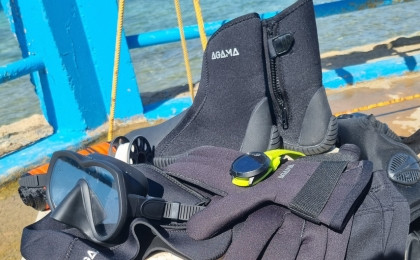Instructions on how to choose a wetsuit
27. 2. 2024
Tips and advice on how to choose the right wetsuit. In our article you will read how neoprene works, what thickness to choose and how to care for neoprene.
How neoprene material works
Neoprene material is optimal due to its excellent thermal insulation properties. Neoprene is a flexible rubber material with a foam structure (closed air bubbles inside the material). Neoprene itself is impermeable (unless it is a dry suit), water will always get in through the edges and seams (except taped seams). Neoprene works by retaining a thin layer of water underneath, which is between the neoprene and the skin. Contact with the water and the heat from our body will then cause the water to warm up, acquire insulating properties and thus prevent possible chills from the cold water.
Basic functions of neoprene
- Thermal protection
- Abrasion protection - neoprene reduces the risk of abrasions on stones or corals.
- Elasticity and flexibility - neoprene is an elastic material, which ensures flexibility and freedom of movement.
- Sun protection - all wetsuits provide a high level of protection against harmful sunlight.
What size wetsuit to choose?
When trying it on, the wetsuit should be easy to put on and you should be able to squat comfortably in it. The ends of the sleeves should reach just above the wrists and on the legs just above the ankles, although this may depend on your height. At the same time, it should not form stores of excess material anywhere, which usually happens in the crotch and armpit areas, so it is important to carefully check these areas. Neoprene should also not constrict or be too tight anywhere. A wetsuit that is too tight will limit your freedom of movement, it can cause poor circulation in the limbs, which leads to faster fatigue and loss of strength, especially in the arms. A neoprene suit should fit perfectly on the body, must not contain any loose parts where water could collect, and at the same time should ensure comfort during movement. If the standard cut of ready-to-wear wetsuits does not fit you, our seamstresses can make minor adjustments to make the suit fit you perfectly.
If you will be purchasing a suit via the e-shop, we recommend measuring yourself and comparing the measurements with the manufacturer's size chart.
Basic classification of wetsuits
- Neoprene short - a short model designed for warmer waters with material thickness from 0.5 - 3 mm.
- Neoprene wetsuit (full-body neoprene suit) - suitable for a wide range of temperatures from warm to cold waters, with material thickness ranging from 0.5 to 8 mm.
- Neoprene raft pants or Long John - suitable for all types of boats, especially for rafters.
- Dry neoprene suit (neoprene dry suit) - as the name suggests, it ensures complete waterproofness.
You can also meet the division of wetsuits into wet and semi-dry ones. Wet and semi-dry wetsuits are structurally identical. However, semi-dry suits provide better thermal comfort thanks to sealing cuffs on the sleeves and legs, which limit the exchange of water in the suit. If we were to sum it up, "wetsuits" are suitable for warmer waters, where the flow of water is not so much a problem, on the contrary, semi-dry suits for colder waters.
In our offer you have the opportunity to choose - women's wetsuits, men's wetsuits and children's wetsuits, in different thicknesses, colors and from several proven manufacturers.
Front or back zipper?
This recommendation cannot be clearly determined, it always depends on individual preferences. In general, however, we can say that for diving we would recommend a wetsuit with a zipper at the back, in the front part of this wetsuit there is a "stand" at the neck, so it seals better and less water gets into it. For other water sports such as paddleboarding, surfing, windsurfing, etc., you can choose a zipper in the front, even for snorkeling in warm waters.
Neoprene shorts or overalls?
Neoprene shorts are usually chosen for snorkeling in sunny weather. The short neoprene perfectly protects the middle of the body and keeps it warm. If you plan to snorkel longer or in colder water, we recommend using a wetsuit. This also applies if there is a risk of rubbing against stones or corals in the water. The greater the depth, the greater the cold, divers are advised to wear wetsuits with a hood, or to purchase a neoprene hood separately. For water sports, such as paddleboarding, surfing, wakeboarding, etc., neoprene overalls or 3 mm shorts are often used, they ensure good thermal insulation and mobility. However, the temperature of the water must always be taken into account.
Neoprene thickness
The thickness of the neoprene is given in millimeters. The thickness of the material used has the greatest influence on our thermal comfort and overall perception. As the thickness of the neoprene increases, its ability to insulate and thus the feeling of warmth increases. On the other hand, as the thickness of the neoprene increases, mobility decreases.
Care of wetsuit
After each use in sea or pool water, it is important to rinse the suit gently in cold water and hang it on a good quality, wide hanger to prevent damage to the shoulder area. Avoid drying the suit in direct sunlight. Let the inside of the suit dry first, then turn it inside out and dry the outside as well. Occasionally wash the suit in a diluted detergent or ideally with a special shampoo for neoprene. A neoprene suit should never be squeezed. Improper storage of the suit in a folded or crumpled state can lead to its damage, cracking or tearing of the material. The best place to store the suit is a dry, dark place away from heat sources where the suit will be hung.



